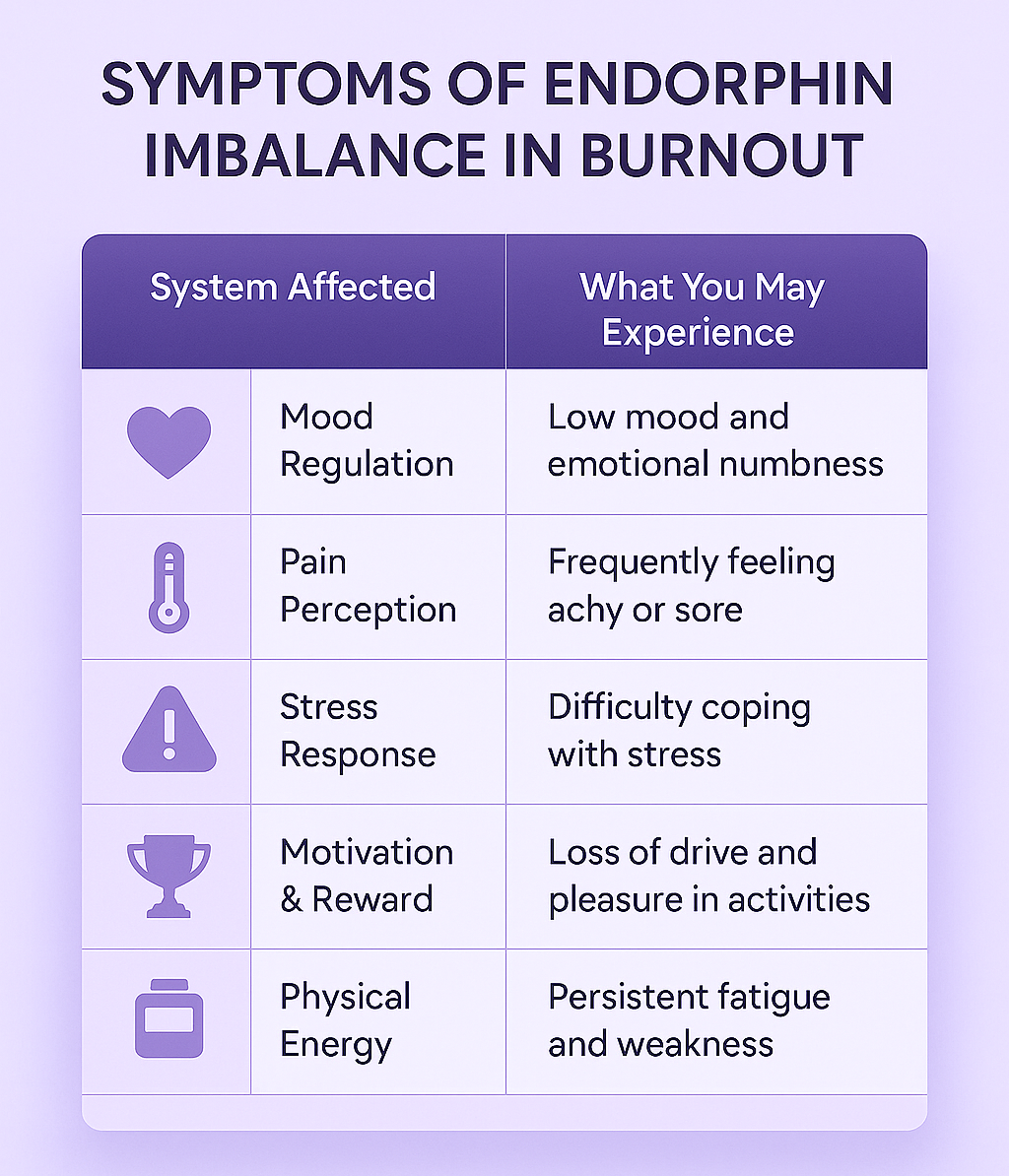Endorphins and Burnout: How Stress Steals Your Natural Pain and Pleasure Relief
Have you ever noticed that during stressful periods, even your favorite activities don’t bring you joy? Or that you feel more aches and pains than usual? Burnout may be depleting your body’s endorphins.
Endorphins are your body’s natural “feel-good” chemicals. They relieve pain, boost pleasure, and create a sense of well-being. Chronic stress and burnout can suppress endorphin production, leaving you emotionally flat, physically sore, and mentally drained.
This blog explains what endorphins do, how burnout affects them, and how to help your body bounce back.
What Are Endorphins?
Endorphins (short for endogenous morphines) are neuropeptides produced mainly in the brain and spinal cord. They help:
Block pain signals
Promote feelings of euphoria
Reduce stress
Regulate mood
Endorphins work by binding to opioid receptors, much like prescription painkillers, but without the harmful side effects.
Endorphin Pathways in the Brain
Endorphins are released by the pituitary gland and hypothalamus and act on several key brain areas:
Amygdala: Controls emotions
Nucleus accumbens: Generates feelings of reward and pleasure
Spinal cord: Modulates pain perception
Periaqueductal gray (PAG) of the midbrain: Major center for pain modulation and suppression of pain signals
One of the most potent endorphins, known as beta-endorphin is derived from proopiomelanocortin (POMC), a large precursor protein produced mainly in the pituitary gland. POMC is cleaved to form beta-endorphin, responsible for pain relief and mood elevation.
Endorphins primarily bind to three opioid receptor subtypes:
Mu-opioid receptors (MOR): Located mainly in the brainstem, thalamus, and PAG; responsible for analgesia and euphoria.
Delta-opioid receptors (DOR): Found in the cortex and limbic regions; involved in mood regulation.
Kappa-opioid receptors (KOR): Present in the hypothalamus and spinal cord; regulate stress response and dysphoria.
How Burnout Reduces Endorphins
1. Chronic Stress Depletes Endorphins
Long-term stress overstimulates the hypothalamic-pituitary-adrenal (HPA) axis, reducing the body’s capacity to produce endorphins.
2. Less Frequent Natural Release
People experiencing burnout often stop exercising or socializing, reducing natural endorphin release.
3. Increased Pain and Discomfort
With fewer endorphins, pain signals become stronger and harder to tolerate.
4. Emotional Numbness
Low endorphin levels may contribute to the emotional flatness or “blunting” often reported in burnout.
Symptoms of Endorphin Imbalance in Burnout
Why Endorphins Matter in Burnout
Endorphins are your body’s natural painkillers and mood stabilizers. Low levels lead to:
Heightened physical and emotional pain
Decreased motivation
Reduced enjoyment of life
This creates a vicious cycle where stress and discomfort further reduce endorphin production.
Can You Rebuild Endorphin Levels?
Yes. With targeted activities, you can naturally boost your body’s endorphin production.
1. Engage in Exercise
Aerobic activities like running, dancing, and swimming are powerful endorphin boosters.
2. Laugh and Connect
Laughter and positive social interactions naturally release endorphins.
3. Eat Spicy Foods
Capsaicin in hot peppers triggers mild endorphin release.
4. Meditation and Deep Breathing
These practices lower stress and promote endorphin balance.
5. Try MelodiaSync
EEG-guided sound therapy like MelodiaSync promotes relaxation, helps reduce stress, and supports the body’s natural chemical recovery.
How MelodiaSync Can Help
MelodiaSync’s EEG-guided relaxation programs are designed to:
Calm the overactive stress response
Help regulate brain activity for mood stability
Support recovery of endorphin balance
Regular use can help break the stress-fatigue cycle common in burnout.
Final Thoughts: Get Back to Feeling Good
Burnout robs your brain of endorphins, your body’s natural feel-good messengers. But with intentional steps, you can restore balance.
Exercise, laughter, relaxation, and neuroscience-backed tools like MelodiaSync can help you regain energy, joy, and resilience.
Your spark isn’t gone, it just needs a little help to shine again.
Disclaimer: This blog post is intended for informational purposes only and does not constitute medical advice. Please consult a qualified healthcare professional for any medical concerns or treatment decisions.



